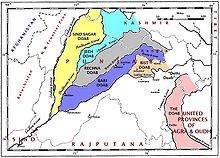Doab
Doab ( Hindi : दोआब , Urdu : دوآب, Doāb ) describes a mostly very fertile region in South Asia between two rivers.
etymology
The name Doab comes from Persian and is composed of do for "two" and āb for "water, river" (cf. also Punjab ). At the edges of the rivers there are often flooded lowlands ( khadir ), the central area, on the other hand, consists of extremely fertile and flood-proof loam soils ( bangar ), which were raised during the Pleistocene and offer the best conditions for arable farming.
The doab
In particular, the term “Doab” refers to the alluvial land between the Ganges and Yamuna rivers in northern India. Both rivers arise in the Himalayas and flow almost parallel for more than 500 km through the Ganges plain before they unite in Prayagraj . Between them lies the Doab, which is an average of 100 km wide. Because of the frequent floods in earlier times and because of the lack of stone material, with the exception of a few buildings in Meerut and the Gupta-era brick temple of Bhitargaon, there are neither medieval temples nor major cities steeped in history. The British built the Ganges Canal here in the mid to late 19th century to regulate the water and irrigate the agricultural areas .
Other doabs
The term “Doab” is also used for other regions, such as the areas between the rivers of the Punjab or the Raichur Doab between the rivers Krishna and Tungabhadra in southern India.
literature
- Hans-Georg Bohle: “Ecological Basics: Natural Space and Climate”. In: Dietmar Rothermund (Ed.): India. Culture, history, politics, economy, environment. A manual. Munich: Verlag CH Beck, 1995. pp. 19-37.
- The Imperial Gazetteer of India. London 1908. Headword: Doāb . Vol. 11, p. 364 f.
Web links
- Ganges-Yamuna-Doab - Description ( Encyclopaedia Britannica , English)

